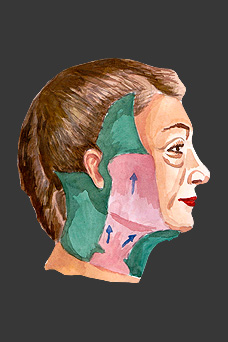Facial surgery
Facelifts
Breast surgery
Other operations
Non-surgical procedures
Facelifts
Facelifts are a surgical procedure designed to eliminate or to reduce signs of aging in the face and neck. Sagging of the middle part of the face can create deep creases under the lower lid and between the nose and the upper lip (nasolabial fold), so the face looks tired and sad. Facial fat redistribution and loss of facial muscle tone can accompany sagging dewlap, the appearance of whiskers and neck wrinkling.
Although facelifts are designed to correct the signs mentioned above, this procedure is still highly individual because all faces age differently. Sometimes it might be appropriate to perform a lift of the middle part of the face only, while in other cases a traditional face-lift might be recommended. Often facelifts are performed alongside other facial procedures such as blepharoplasty, nose correction, fat grafting, injection of fillers and so on.
Procedure
The traditional facelift includes a forehead lift, mid-face lift, and chin and neck correction. The surgery is performed through incisions made at the hairline at the forehead, temples and around the ears, so the scars are hidden well after they heal. At this clinic, facelifts are performed using an advanced endoscopic technique that allows us to perform the operation through even smaller incisions. The key purpose of the surgery is not only to tighten the skin and smooth out wrinkles, but also to lift the subcutaneous layer and muscles of the face, and to perform the correct facial fat redistribution.
Facelifts are a surgical procedure designed to eliminate or to reduce signs of aging in the face and neck. Sagging of the middle part of the face can create deep creases under the lower lid and between the nose and the upper lip (nasolabial fold), so the face looks tired and sad. Facial fat redistribution and loss of facial muscle tone can accompany sagging dewlap, the appearance of whiskers and neck wrinkling.
Although facelifts are designed to correct the signs mentioned above, this procedure is still highly individual because all faces age differently. Sometimes it might be appropriate to perform a lift of the middle part of the face only, while in other cases a traditional face-lift might be recommended. Often facelifts are performed alongside other facial procedures such as blepharoplasty, nose correction, fat grafting, injection of fillers and so on.
Procedure
The traditional facelift includes a forehead lift, mid-face lift, and chin and neck correction. The surgery is performed through incisions made at the hairline at the forehead, temples and around the ears, so the scars are hidden well after they heal. At this clinic, facelifts are performed using an advanced endoscopic technique that allows us to perform the operation through even smaller incisions. The key purpose of the surgery is not only to tighten the skin and smooth out wrinkles, but also to lift the subcutaneous layer and muscles of the face, and to perform the correct facial fat redistribution.
| Face-lift | ||||
 |
 |
 |
||
| Vectors of tissue tension | Vectors of tension of skin incision | Postoperative scar | ||
| Proportion of different parts of the face before and after face-lift | ||
 |
||
| Before / After |
Operation risks
Facelifts, like any other intervention, may have adverse effects such as reactions to anaesthesia, postoperative pain, swelling, tightness, tissue fluid or blood accumulation, and eye irritation. More rarely patients might experience prolonged bleeding, wound edge separation, wound infection or scar hypertrophy. Other possible complications or adverse reactions should be discussed with the plastic surgeon during the consultation.
Postoperative period
Usually patients return to work after 2-4 weeks, but it can take up to 6 months for the bruises to disappear and for the scars to finish healing. You may need to use additional cosmetics during this period.
The cosmetic effect of a facelift can last for years or decades, but depends to a large extent on the patient’s lifestyle.
Facelifts, like any other intervention, may have adverse effects such as reactions to anaesthesia, postoperative pain, swelling, tightness, tissue fluid or blood accumulation, and eye irritation. More rarely patients might experience prolonged bleeding, wound edge separation, wound infection or scar hypertrophy. Other possible complications or adverse reactions should be discussed with the plastic surgeon during the consultation.
Postoperative period
Usually patients return to work after 2-4 weeks, but it can take up to 6 months for the bruises to disappear and for the scars to finish healing. You may need to use additional cosmetics during this period.
The cosmetic effect of a facelift can last for years or decades, but depends to a large extent on the patient’s lifestyle.
| Tautrimas Aštrauskas - Certified Plastic & Reconstructive Surgeon www.blossomandjasmine.com |
 |
 |
 |
solution: inverse.lt |
